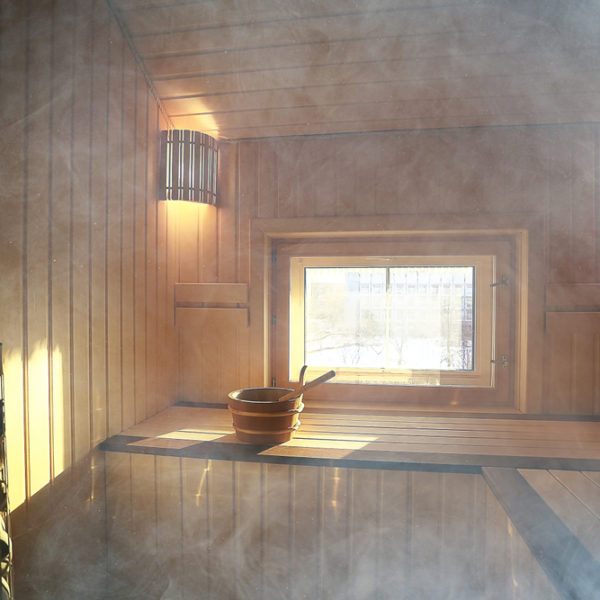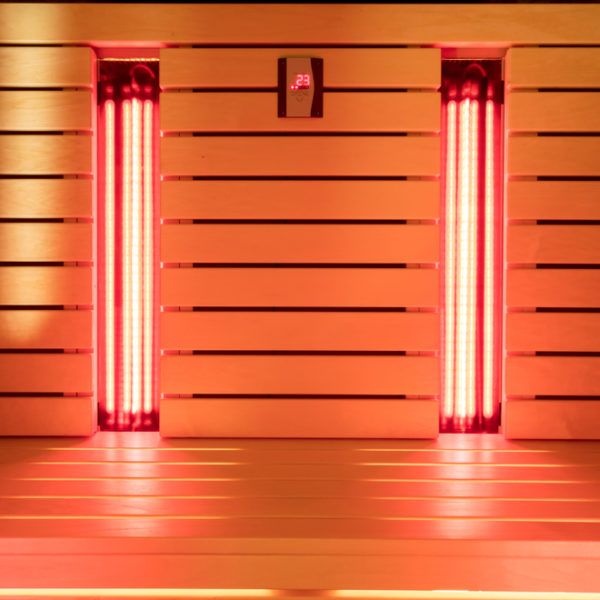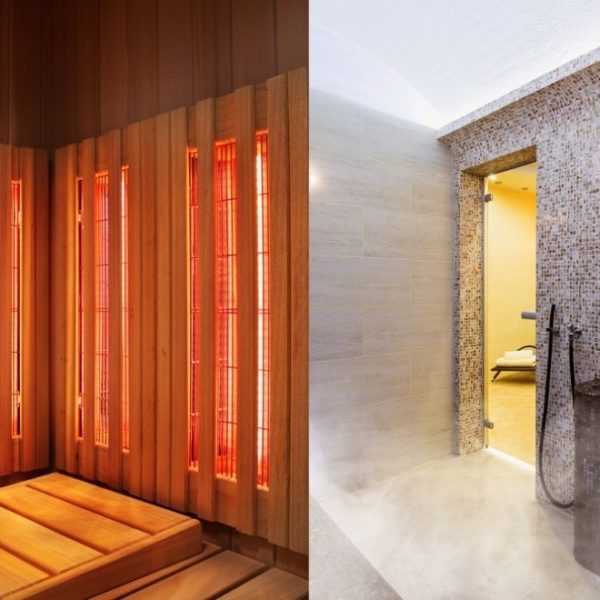If you hear the word sauna whispered from across the room, think of the first word that comes to mind. Mine is- RELAXATION!
In this article, I will expose you to the four main types of saunas available today. Then, we will briefly look at their origins and uses and finally cover the multitude of benefits available from heat+sweat therapy.
What is a Sauna?
In its basic form, a sauna is an enclosed space, usually with a wooden interior, that uses heat to warm the area within the temperature range of 110 and 200 degrees Fahrenheit.
Saunas produce its beneficial results through a coveted heat+sweat therapy by implementing various heating methods. Generally, a sauna may be wood-burning, electrically heated, steam generating, or use harmless infrared through specific lamp technology to provide the unit’s respected heat and humidity levels.
Types of Saunas
This article aims to introduce you to the four most common saunas available. However, the sauna market offers its products in various sizes, models, and configurations to meet customer demands.
The four main saunas include the traditional Finnish steam sauna, electric, steam bath, and infrared sauna. Lastly, we will look at a sauna blanket that puts infrared technology into a fold-up accessory for your routine health and wellness therapy.
1. Finnish Steam Sauna
Commonly referring to the traditional sauna, the methodology for heating is relatively simple. Best known as a ‘dry’ sauna compared to higher-humidity alternatives, Finnish saunas operate by heating rocks over a wooden fire. In addition, a bucket of water and ladle accompany the setup allowing one to increase the amount of steam as desired.
These saunas can reach scorching temperatures of up to two hundred degrees Fahrenheit. Thus, your body temperature increases relative to the increasing temperature in the room.
FUN FACT: According to the Sauna Society, “sauna is the only Finnish word in the English dictionary.”
Origin
The Finnish sauna has been in use for at least 2000 years as a holistic health practice. So much that more than half of the Finnish population owns a personal sauna.
That’s right, approximately 3 out of the 5 million people populating Finland have a sauna “in homes, offices, factories, sports centers, hotels, ships and deep below the ground in mines.”
Uses
The brave-hearted Finns have perfected the sauna experience over the years. They will gladly run out bare-naked from a 200-degree room and jump into a small hole cut out of ice on the lake.
Another cool-down alternative includes rolling around, again bare naked, in a patch of clean, fresh snow in a similar fashion to a dog trying to remove an itch.
For those who like to hold on to tradition, one may even utilize a vihta to sprinkle cool droplets over their steaming bodies. Or there is almost the option of jumping under a cold shower.
Interestingly enough, the average Finnish family unit will visit the sauna weekly. This cultural tradition includes all family members, even babies.
Yes, you heard that correctly!
Nowadays, the majority of women will birth in the hospital, however;
“about a hundred years ago, 95% of all births in Finland were home births, and usually mothers gave birth in the sauna.”
Because of this convention, it would be pretty standard practice for a baby to have their first sauna experience during their first minutes of life. But, of course, today, babies experience their first sauna session a little later in life.
Still, parents have a good understanding of heat exposure and the limitations associated with introducing a child to the sauna so that they too can become part of the family tradition.
Benefits
- stress relief, relaxation, and sleep improvement
- mental health
- chronic pain relief
- lowers inflammation
- cardiovascular benefits to include respiratory wellness
- fitness performance and muscle recovery
- detoxification
- enhanced weight loss and increased metabolism
2. Dry Sauna
Like its Finnish uncle in design, this type of sauna is a dry model that generates heat using an electric heater, usually mounted to the wall or floor.
Often, these electrically heated configurations come outfitted with a user-friendly control panel that includes both temperature and time control- some even come with a portable remote.
Moreover, just as capable of reaching high temperatures as a traditional sauna, electric models have a lower humidity output. This alternative usually lacks the use of a kiulu (sauna pail) and loylykauha (steam ladle), although you can add water to the rocks in an electric sauna.
Origin
Electric saunas were developed in the 1950s and quickly gained popularity in the United States as this relaxed chamber suddenly became much more accessible to the community at large.
Because not everyone has a separate building on their property that they can dedicate as a sauna house, the design of electric heaters made the sauna culture explode beyond borders.
The founders of sauna therapy would be proud that their invention now provides benefits to people cross-culturally.
Uses
The electric sauna model is energy-efficient; thus, this is the most commonly found type of sauna today. These saunas can be found in gymnasiums and other private holistic centers but have increased as a sought-after commodity for the private home.
Benefits
- soothes and relaxes tired muscles
- relieves mental tiredness
- promotes a healthy balance of blood vessels
- provides pain relief from arthritis
- stimulates the immune system
- relieves congestion
- promotes healthy skin
- promotoes weight loss
3. Steam Bath
More synonymous with a Turkish-style bath than a sauna, the humidity level reaches 100 percent within these enclosures. Worth noting, these enclosures are different from their counterparts; instead of wood, manufacturers use various waterproof materials such as tile, stone, glass, or acrylic in the build of a steam bath.
Origin
Steam bath’s more closely resonate with the times of the ancient Turks, Romans, and Greeks. Then, bathing was viewed as a ritualized practice as cleanliness symbolized health- which therefore meant paying homage to their gods by maintaining their bodies in optimal shape.
These cultures were known for their incredible structures, which still stand today and have become attractions for the global tourism industry. Their bathing facilities followed suit with stunning mosaics and marble structures adorning the open space.
Uses
You can likely find steam baths in wellness spas, hotels, and world-class resorts around the world. Fitness and leisure centers will also have this commodity as professionals commonly take advantage of this post-fitness therapy. Its lower temperature, typically hovering around 110-120 degrees Fahrenheit, is adapted to its benefits.
Benefits
- can help prevent skin breakouts
- helps workout recovery
- reduces anxiety
- eliminates excess sodium
- removes lactic acid from muscles
- clear sinuses
- conserve water
- fosters well being
- detoxification
- does not require a dedicated room- can be added to an existing shower
WATCH this video for a comparison between a steam bath and a sauna.
4. Infrared Sauna
Infrared saunas are pretty different from the other types discussed above because there is no humidity associated with the therapy. Instead of heating the space, infrared heat directly penetrates your skin; this is significant to this sauna type’s popularity and research-backed advantages.
Furthermore, you should know that there are two types of infrared saunas– the difference lies in the wavelength of the light heat emitted. Three ranges along the infrared spectrum are each specifically directed towards particular therapeutic benefits.
Near-infrared, by far the shortest wavelength is absorbed right below your skin surface, promoting skin cell regeneration and revitalization.
Mid-infrared, are longer than near-infrared wavelengths and are effective at improving your circulation and increasing healing times.
Far-infrared, the longest wavelength, penetrates the deepest and is best adapted for weight loss, detoxification, and increased blood flow.
Origin
The original patent for infrared sauna technology issued in 1965 to a Japanese doctor catalyzed the development of a lamp technology that directly penetrates skin tissue and raises one’s body temperature more effectively.
Infrared saunas reproduce the invisible rays that emanate from the sun without the harmful effects. The benefits that our bodies receive from daily exposure to the sun go without contest.
This technology avoids the harmful effects of overexposure to the sun, and its lower heat allows you to enjoy a more extended therapy session. Additionally, breathing inside these infrared chambers is much easier without the steam and high humidity that come on par with other sauna types.
Uses
Infrared saunas come in many shapes and sizes, and now people are beginning to purchase these units for their home enjoyment. These units are extremely energy efficient and may increase the resale value of one’s home.
You may also find one of these units in day spas, doctors’ offices, dermatology practices, and wellness centers alike. In addition, smaller portable options and hand-held devices are also readily available for online purchase for those wanting to supplement their weekly office visit with home therapy.
Benefits
- heal and rejuvenate skin
- acne relief and treatment
- asthma relief
- promotes muscle and tissue repair
- pain relief
- dissolved tension
- improved digestion
- weight loss
- energetic mindfulness
- increased blood flow for better circulation
- detoxification
- improves congestive heart failure and peripheral artery disease (as found in Japanese therapy literature)
Sauna blankets are a trendy alternative for the traditional 4-walled infrared sauna enclosure. It wraps all of the benefits of infrared around you in blanket form.
Sauna blankets are advantageous because of their spa-like benefits, including detox, inflammation reduction, pain relief, and boosted blow flow. In addition, consumers also boast about body fat loss, immune system support, better mood, mindfulness, and sleep quality benefits.
Touted as the original sauna blanket, Ray Sauna is perhaps one of the top quality and highly recommended products available. In contrast to an infrared sauna that has full spectrum options, their sauna blankets offer far infrared technology- the same technology dating back to 1965 and the first infrared saunas.
Most Recommended
I’d have to say, if, given the experience, I would love an invitation to a local steam spa in Finland, followed by a run through the snow until an eventual plunge into the freezing waters of a winter lake.
WATCH this vlog to get some humorous insight into one American couple’s experience in Finland.
But hey!!- it’s not for everyone and perhaps not your style. And that is entirely understandable. So, the next best alternative would be a trip to the infrared sauna.
You can easily book your first session by contacting a local spa, wellness center or even check with your medical office for any specialized treatment centers in the area if you have a specific condition you want to address.
Remember first to seek medical clearance if you are in an at-risk category. Then, spend the time researching well-reviewed clinics with specialized assistance to make your first experience as memorable as possible.
Then, it’s sure you will be moving things around on your schedule to accommodate your weekly sauna sessions. Enjoy!
Medical Concerns
Various research and study indicate that sauna use is a generally safe therapy for the majority of people. For this reason, people with physically inhibiting conditions especially enjoy taking regular trips to the sauna.
You may have heard that a sauna session is similar to running a half-marathon. Although internal physical conditions appear to rise, a 30-minute stay in the sauna is perhaps more comparable to a moderate-intensity workout.
Contrary to popular belief that a sauna session will lower blood pressure, studies indicate that blood pressure rises in individuals. What is fascinating is the come-down effect on an individual’s cardiovascular system after the session is over.
And although one’s heart rate experiences similar positive effects of exercising, the lack of muscle activity detracts from that full-body workout effect.
The moderate use of the sauna is safe for most people; however, if you suffer from cardiovascular disease, you should speak first with your doctor. And if you take regular medications, have a known medical illness, or are pregnant, you should consult with your specialist.
In addition to attaining medical clearance, there are several precautions users should take. To avoid adverse effects, please follow the following advice:
- avoid alcohol consumption before visiting the sauna
- limit sessions to 15-20 minutes in duration
- an adult should always accompany young children
- stay hydrated throughout your visit to the sauna
- remove all jewelry and dress appropriately
- rest afterward so your body can efficiently regulate itself
- take a cool shower to remove sweat and
Conclusion
The sauna, regardless of type, is a “poor man’s pharmacy”- the health advantages are too many to ignore. But, even if you are not particularly interested in its medical benefits, a trip to the sauna will prompt you to release, relax, and rejuvenate at the least.
Please share any thoughts or concerns about the benefits of a sauna experience in the comments and questions below.












